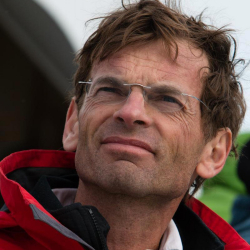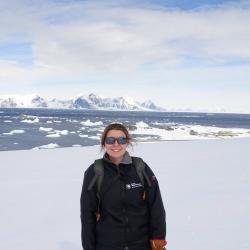Snow on Ice: Sea pigs and mud #10
“We found a sea pig last night in one of the Megacore tubes,” Jennie Mowatt, a marine technician onboard, nonchalantly said as she passed around a video on her cell phone for all of the scientists in the meeting. With my late-night schedule, I had literally just thrown myself down from my top rack (bunk on the ship), gotten dressed and walked a couple rooms down to join our daily 0830 science planning meeting, eyes barely starting to open and adjust to the light.
Eric Rignot is a glaciologist and remote sensing scientist at UC Irvine and at NASA's Jet Propulsion Laboratory. He is interested in ice sheet mass balance and ice-ocean interaction in Greenland and Antarctica. As part of MELT, he will provide to the team the latest information on the grounding line position of Thwaites from satellite interferometry and will generate remote sensing estimates of ice shelf melt to be compared with data to be collected in the field.
Rob Arthern is a glacier modeller at BAS. He will be responsible for modelling the evolution of Thwaites Glacier, specifically in response to the melt rates at the grounding line determined both by direct observations, and by the grounding zone parameterization to be developed within the MELT project. He is also a scientist on the GHOST team.
Keith Makinson is a physical oceanographer at BAS, and is responsible for developing hot-water drills used by BAS. Within MELT, he will be responsible for the hot-water drilled access holes and ensuring instrumentation can be safely deployed through them. He will also be active in the interpretation of the ocean datasets from the sub-ice shelf environment, particularly with respect to tidal activity.
Paul Holland is an ice-ocean modeller in the Shelf Seas group at the British Antarctic Survey. He will be responsible for coordinating the different modelling components of the project. In particular, he will assist with the installation of the grounding zone parameterization into MITgcm.
Professor Paul Brennan is a co-investigator for MELT. He is responsible for developing novel instruments to be deployed in a borehole upstream of Thwaites Glacier grounding line that will be used to measure the vertical shear in the ice column. These results will be used to help validate, amongst others, the WAVI model of ice sheet evolution.
Professor Matt Piggott is a co-investigator of MELT. He is responsible for applying leading-edge techniques in numerical modelling to the ocean environment in the grounding zone of Thwaites Glacier. The aim is to create a parameterization, validated by in situ observations, of the rate at which the base of the ice shelf in the grounding zone is melted by the ocean.
John Paden is the signal processing lead at the Center for Remote Sensing of Ice Sheets. He is a Co-Investigator on the MELT project. Paden will assist in the Accumulation Radar system engineering and he and a graduate student will process the Accumulation Radar data. This radar is taking airborne measurements along flow-lines aligned with each of the MELT field sites. The measurements will be repeated three times to measure melt rates. These measurements will also assist in choosing the locations for ground based work.
Elena Field leads the UK Thwaites–related map products for the ITGC.















